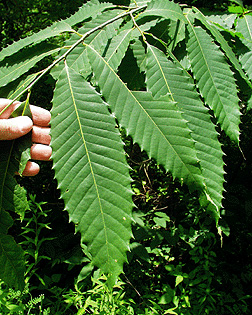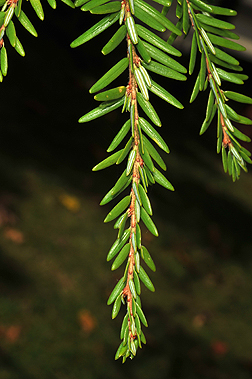
Virginia pine has needles. Needles are found on most conifers and gymnosperms.

American chestnut has a broad leaf. Most angiosperms are broadleaves.
Continue to LEAF Arrangement >>>
The first step in using leaves to identify trees is to determine if the tree has needle-like foliage (conifers or gymnosperms) or broad leaves (angiosperms). Trees with needle leaves are often called softwoods because their wood is generally soft. Broadleaf trees are often called hardwoods because their wood is generally hard. There are (of course) exceptions to this broadleaf/needleleaf split - ginkgo is a gymnosperm with very broad leaves!

Virginia pine has needles. Needles are found on most conifers and gymnosperms.

American chestnut has a broad leaf. Most angiosperms are broadleaves.
Broadleaf species can also be classified as either simple (one leaf blade) or compound (several to many leaflets per leaf). While a compound leaf looks like a number of simple leaves attached to a twig, the rachis (the midrib to which the leaflets attach) has no buds, is not particularly woody, and is shed in the fall.

Simple leaves have a single leaf blade, as seen on northern red oak.

Compound leaves have several leaflets attached to a midrib or rachis, as seen on this black walnut leaf.
Leaves can grow on conifers as either scales, single needles, or in groups called fascicles. Cedar leaves grow as scales. Spruces, firs, hemlocks as well as others grow single needles. Pines grow needles in fascicles, or bundles of needles.

Scales of a northern white-cedar.

Single-needles of a hemlock.

Two-needles per fascicle on a Table Mountain pine.

Three-needles per fascicle on a loblolly pine.
Continue to: